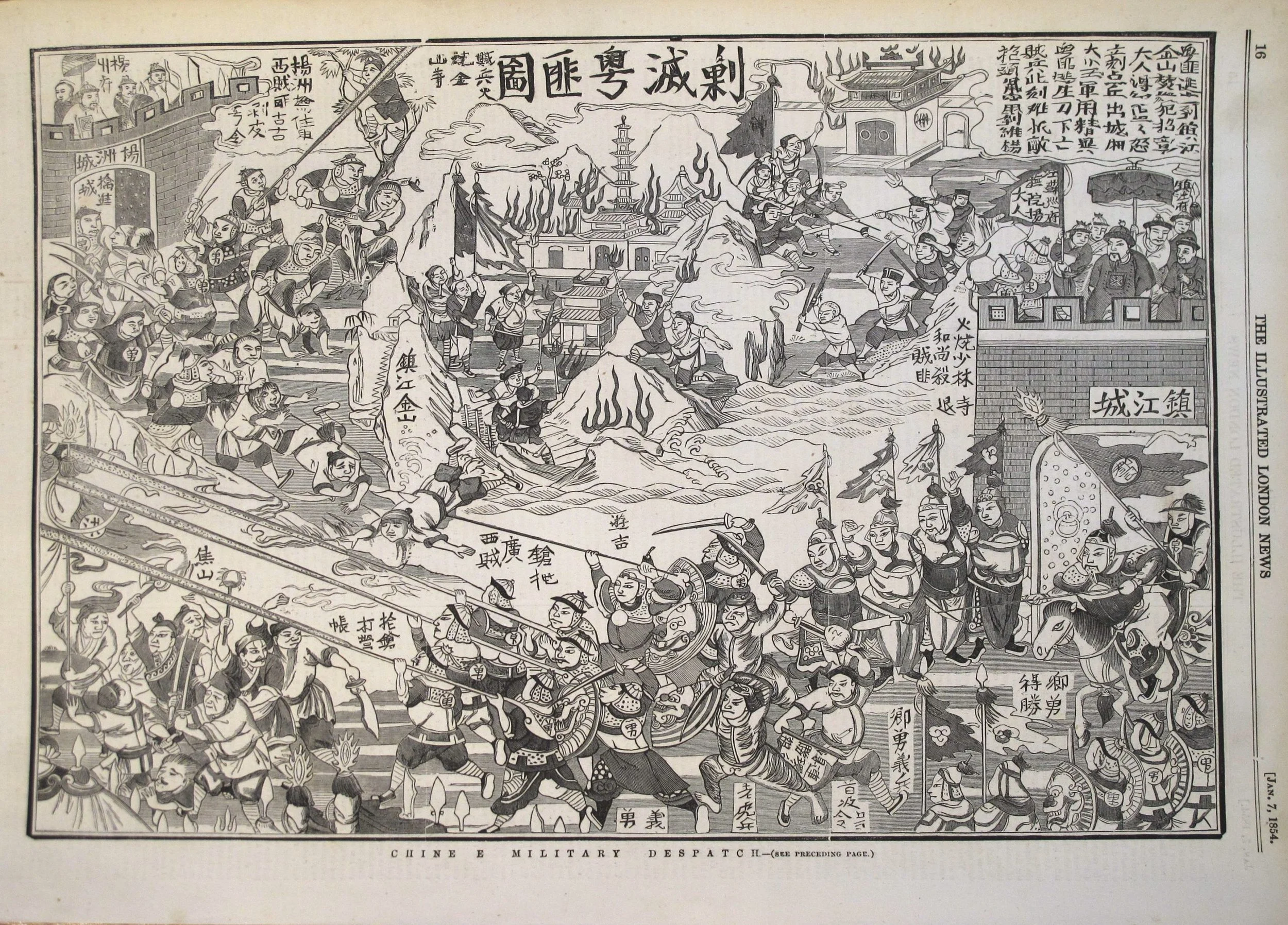Suppression of the Taiping Rebels: 剿滅粵匪圖
Suppression (or “extermination”) of the Yue Bandits (or “Taiping Rebels”)
Here’s a woodblock Victory Print from the 1850s titled “Suppression of the Taiping Rebels”. Well, more or less; the title actually calls the Taipings粵匪, “Yue Bandits”. The first-century BC Yue kingdom included parts of Guangdong, Guangxi and Vietnam, used here because the Taiping movement began in Guangxi (the rebels were known by other names too, such as “Longhairs”).
Anyway, Victory Prints, full of action and always showing the enemy being routed by government forces, probably trace their origin to Ming dynasty woodblock illustrations for warrior novels such as the Water Margin. By the eighteenth century full-sized mythical battle scenes along the same lines were being designed as New Year prints, and it was around this time that a set of similar engravings were made in Europe for the emperor Qianlong, showing his victories against ethnic groups along China’s western borders. Victory Prints, which first appeared a century later during the Taiping Rebellion and served as news sheets for current events, drew on all these sources – something to explore in a later blog post.
So, back to “Suppression of the Taiping Rebels”. The print shows two theatres of action during early April 1853, when the Yangzi river cities of Zhenjiang (famous today for its black vinegar) and Yangzhou (fried rice) were attacked by Taiping forces, who were on a roll after taking the enormous and historically important city of Nanjing as their capital just a few weeks earlier.
The right side of the print shows three divisions of Imperial troops pouring out of the main gate of Zhenjiang city while the Jiangsu acting provincial governor Yang Wending (楊文定; under the umbrella) and his entourage look on. Wearing studded, padded armour, the troops below include cavalry and infantry armed with muskets, swords and spears (plus two “tiger soldiers” in full costume), and are driving a fierce band of rebels off into the lower left corner of the print.
Upper centre is little Jinshan Island, just offshore on the south bank of the Yangzi, whose temples are being torched by the rebels, despite a band of heavily-outnumbered monks, wearing black caps and brandishing cudgels and pole weapons, rushing out from behind the city to attack them.
Meanwhile, the upper left shows Imperial infantry armed with swords (and one gun) slaughtering Taiping rebels and driving two prisoners in through gates of Yangzhou, while officials watch from the battlements.
But like all Victory Prints I’ve ever seen, nothing in this picture is true. According to a report which appeared on 28 May 1853 in the English-language North China Herald, and which appears to have come from the official Peking Gazette and information later gathered by British observers:
“On the 31st March, early in the morning, the Insurgent fleet of river-craft sent down from Nanking approached Chin-keang [Zhenjiang]. Only the Macao Lorchas despatched up the river by the Shanghae Intendant attempted resistance, the rest of the Imperial fleet flying in dismay at the sight of the enormous number of vessels moving against them. The Lorchas were also soon forced to retreat and were pursued as far as Silver Island. From this the Insurgents returned to Chin-keang which they occupied unresisted, the garrison, among them 400 northern Manchoos, having fled without firing a shot. The families of the resident Tartars [Manchus], warned by the fate of their compatriots at Nanking [20,000 of whom had been slaughtered by the Taipings when Nanjing fell on 19 March], all evacuated the place to the number of twenty thousand; only a few hundreds were caught and slain in the surrounding villages. On the following day, the 1st April, the Insurgents occupied Kwa-chow and the large city of Yang-chow on the northern bank of the Yang-tsze: in like manner without resistance. A long battery of three miles of guns that lined the river bank fell into their hands. Not one had been discharged against them.”
The cities remained in rebel hands for pretty much the next decade. The unfortunate provincial governor Yang Wending – who had been appointed just two weeks earlier, after his predecessor Lu Jianying was killed during the sack of Nanjing – was accused of cowardice, despite his “Imperial fleet” numbering only eight ships and twelve sampans. Yang was sentenced to death, though this was later commuted to banishment; he died just four years later. Wen Yi (文藝), the general in charge of Zhenjiang’s forces, was also exiled to China’s far northwest, along with most of his underlings – many of whom, however, couldn’t be found.
Version in The Illustrated London News. Nice job; even most of the Chinese is legible
A surprisingly accurate copy of this print appeared in the Illustrated London News in January 1854, so the original – which would have had to travel by sea from China to Britain to be copied for the newspaper – must have been made in 1853. Although Victory Prints apparently illustrated current events, they are never dated and so without this sort of external proof there’s no way to know how soon after the actual events they were made.

